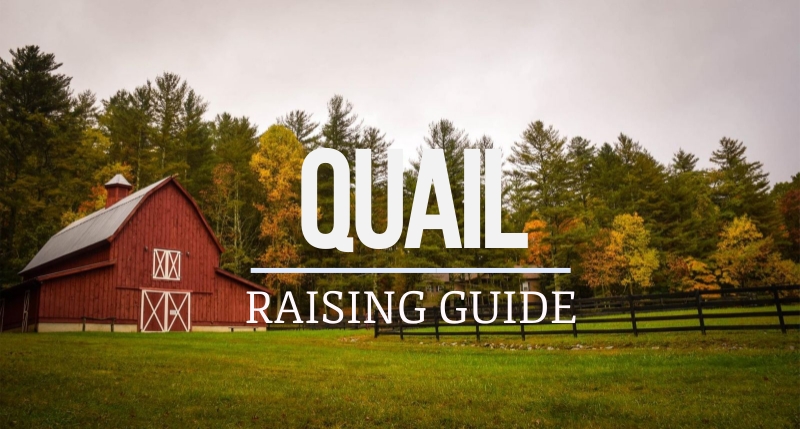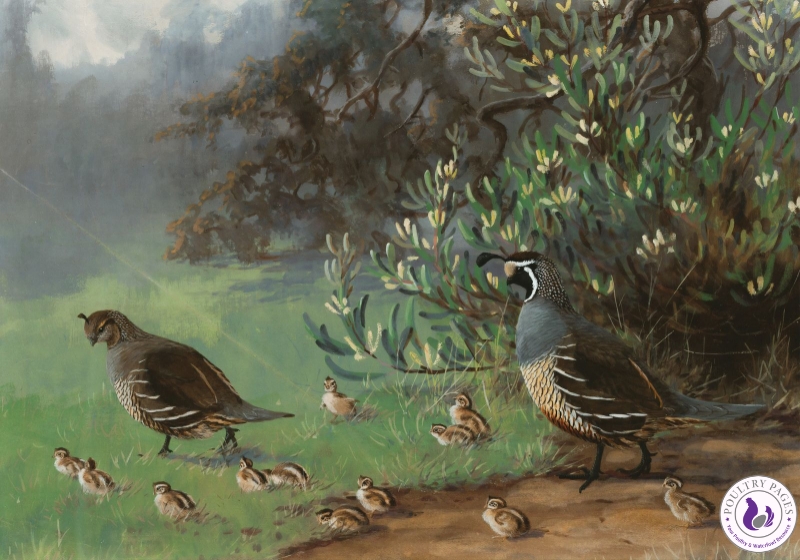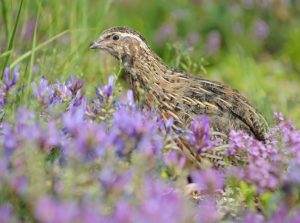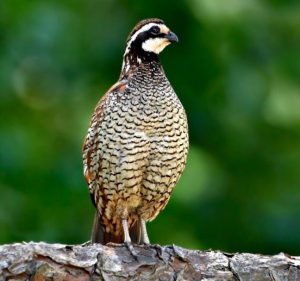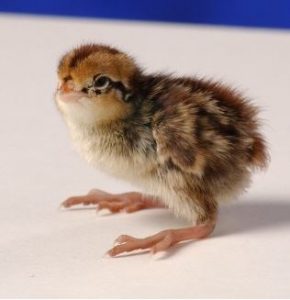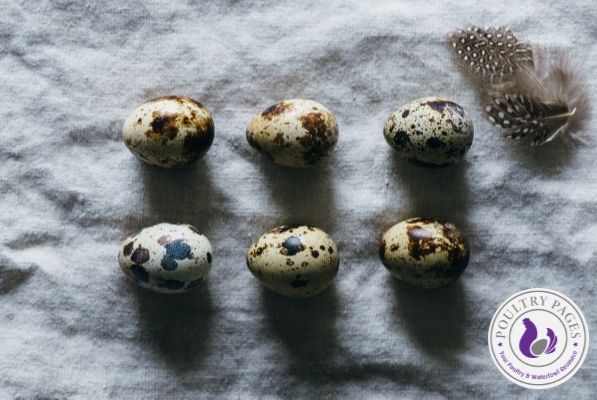What birds hatch quicker, grow faster, start laying eggs sooner, don’t take up a lot of space, eat less, are quiet, and taste great too? That’s right, quail!
An introduction to Quail
Whether you are a rural or urban homesteader and want to start raising your own food supply, or just looking for an interesting new hobby, raising quail can be the perfect step towards your goal. The best thing about raising quail is you don’t need a large farm with a fancy barn to do it, you can raise them in a small backyard space, or even in a cage inside the house. Within a few weeks you can start gathering fresh eggs, and you won’t bother your neighbors either.
Quail might be tiny, but they are mighty birds that have been valued for their meat, prolific egg producing capabilities, and beauty for thousands of years. Quail were probably first domesticated by Ancient Egyptians who needed a quick and easy source of protein to feed laborers building the pyramids. The Ancient Chinese raised quail for their beautiful singing voices, and when they exported the birds to Japan in the 11th century, the Japanese got serious about breeding and raising quail for meat and eggs.
Quail are a type of poultry that come under the order of Galliformes which also includes chickens and turkeys. The many different breeds of quail are divided into two main categories: new world and old world. Old world quail are those in the Phasianidae family and include all the varieties of Coturnix. New world quail are in the Odontophoridae family and include popular breeds like the Bobwhite and Wood quail.
If you are interested in raising quail mainly for egg production, those in the Coturnix genus are your best bet. The most popular breeds in this genus are the Common quail, also known as the European or Pharaoh quail (Coturnix coturnix), and the Japanese quail (Coturnix japonica).
If you have hunting dogs and want to train them using live birds, Bobwhite quail (Colinus virginianus) are a better choice, mainly because they can fly. But don’t count out the Bobwhite species for meat and eggs. They do take a bit longer to mature (2.5 months longer) than the Coturnix breeds, but they do lay eggs and they have a strong nesting instinct unlike the Coturnix who just lay their eggs and leave. If you want to breed quail and don’t have an incubator, you may prefer the Bobwhites.
No matter which variety of quail you choose, the characteristics of all species are similar, and they are not difficult to raise. However, there are important factors to consider, and things to learn before getting started.
Your first priority is to find out if you need a permit to raise quail. Every state in the U.S. has its own requirements for licensing. Most states only require a game bird propagation license if you are planning to sell the birds or their eggs. You most likely will not need a permit if you are raising the birds for personal use. Some states require a permit or breeder’s license for nonnative birds or native birds only, and some states require a permit for any quail species. [Missouri residents are required to have a permit before ordering Quail and often will have to quote this permit number whilst ordering.]
You can easily get all this information by visiting your state’s Department of Natural Resources website. Look under the Fish and Wildlife Division to see whether you need a permit, what the restrictions and allowances are, if they do inspections, how much the permit costs, and when it expires. Some state permits automatically expire on December 31st every year no matter when you apply. In most states the permit costs between $50.00 and $60.00.
Raising quail is rewarding and fun, but it does take commitment. Before taking your final step and bringing home your live birds or eggs for hatching, you need to have everything ready for them. Here is a comprehensive guide to help get you ready for raising quail at home.
What variety of Quail should you get? [Coturnix ‘vs’ Bobwhite]
By now you probably know whether you want to raise quail for their eggs and meat, or if you want game birds for hunting and training your dogs. Now, it’s time to decide what breed of quail to get and how many. Here’s a look at the Coturnix and Bobwhite species:
Raising Coturnix Quail
Coturnix varieties are perfect if you are just getting started with raising quail and you are mainly interested in egg and meat production. They are calm, friendly, and adaptable birds that do well in small spaces. Although there are some slight differences between all the Coturnix varieties, they all have similar characteristics.
In general, Coturnix quail are small and weigh around 3.4 to 4.6 ounces, with the females weighing a bit more than males. Because of their small size and calm temperament, they don’t need a lot of living space. If you allow 1 square foot of space per mature bird, you will have a great living environment for them.
The most commonly sold breeds of the Coturnix genus are:
- The Pharaoh D1 is the largest species in the group. It’s average size is between 3.5 and 5.5 ounces. It reaches maturity at 6 weeks old, begins laying eggs by its 7th week and can lay up to 300 eggs per year. The females have brown and tan speckled feathers, the males have brown and cinnamon colored feathers. The Pharaoh quail are gentle birds, make great mothers, and have a sweet song.
- Golden Manchurian quail reach maturity at 6 to 8 weeks and begin laying eggs around the 7th week and can lay up to 100 eggs per year. They are fat and robust birds weighing between 3 and 6 ounces. They have light gold feathers and the males are more solid in color compared to the gold speckled feathers of hens.
- Texas A and M quail have been bred to grow bigger and can reach between 10 and 14 ounces in 8 weeks. Their meat and skin are a lighter color compared to other varieties and are easier to clean and prepare due to their size.
- Jumbo brown quail grow the fastest and largest with an average weight of 12 ounces. They reach full size at 8 to 10 weeks and begin laying eggs anywhere between 6 to 7 weeks of age. Jumbos have brown, gold, and fawn colored feathers. They are even tempered and do well in small spaces.
Raising Bobwhite Quail
The Bobwhite species of quail have 22 subspecies, with the Northern Bobwhite the most popular. Most people raise Bobwhites for hunting and dog training, but also for their delicious meat. Because Bobwhites are more challenging to raise, they may not be the best birds for beginners. They are great flyers and need large areas enclosed with netting, unlike the Coturnix breeds which don’t mind staying inside. You should allow 4 square feet of living space for each Bobwhite quail.
Bobwhites take about 16 to 20 weeks to reach maturity and do not begin laying eggs until around 24 weeks old. Unlike Coturnix quail, a Bobwhite hen will incubate her own eggs if not kept in captivity. This is a plus if you do not want to invest in, or fuss with an incubator.
Besides the Northern Bobwhite, another popular variety is the Jumbo Bobwhite. These birds reach maturity at around 16 weeks and can weigh between 12 and 14 ounces. They have brown speckled feathers and the male has a white spot with a black frame of feathers under its chin. The female is similar, but its chin spot is light brown rather than white.
If you are not interested in raising quail for eggs, meat, or sport, and would prefer a fun, beautiful house pet, the Button quail is perfect. These colorful birds are tiny, weighing 1.4 ounces on average. They like the warmth and should stay indoors all year round.
There are several varieties of Button quail, each with their own brilliant feather colors. The makes are more vibrant than the females with bright blue, red, or cinnamon colored plumes.
Because Button quail are prone to stress, they do not tolerate handling or cuddling well, but they are pretty to look at.
How many birds should you get?
Buying live birds
If you are going to buy live birds, how many you get depends on several factors. Probably the first point to consider is how much space you have for the quail pens or cages. You can raise about 8 Coturnix quail in a 2 x 4 foot cage comfortably. The more space you have, the more you can raise.
If you have never raised quail before, you may not be sure if this is something you can stick to long-term. If you realize after a few weeks that this hobby isn’t for you, it is better to have fewer birds to take care of.
When you are buying quail from a hatchery, there may be a minimum number of chicks you can buy. In most cases, if you buy chicks, you need to purchase 50 birds per variety. If you buy juvenile birds you have more options, they usually come in 6, 12, or 24 – but at a much higher cost.
If you are raising quail for the meat, you can get away with a higher number of birds initially, since you will have them for a short amount of time. In this case, the number of birds depends on how many you want to dress and use in the end.
How many birds you need if you are raising them for eggs depends on your space, time, money for feed, and what you will do with the eggs. If you are planning to sell them to customers, you need to do some math and figure out what is best for your business plan. Coturnix quail are prolific egg producers, and hens will lay one egg every 24 hours during the warmer months with more hours of sunlight. In the winter, if you provide 12 to 14 hours of light, they will lay an egg a day also.
If you are raising Bobwhites, you will need more outdoor space. Each bird needs about four square feet plus room to fly. How many you get greatly depends on how much space you have.
If you are buying Bobwhite chicks, you may have a 50 unit minimum. Juvenile birds are sold by the piece at a higher cost.
Remember, with both breeds of quail, Coturnix and Bobwhites, you should never purchase only one bird. You should buy at least a pair – one male and one female, but the best sex ratio is one male for every two hens. They also do well with one male for every three hens. Quail are social birds and do not do well alone, they need a mate otherwise they may die.
Buying eggs for hatching
Starting your flock with hatching eggs is probably the most economical way to do it. How many you buy depends on the size of your incubator and how many chicks you want to deal with when they hatch and start to grow. Most online companies have minimum orders of 12 and maximum orders of 100 eggs.
When the chicks hatch and are ready to leave the incubator, they need to go into a brooder to keep warm and safe until they are big enough to move into their final home. You need to take all these steps into consideration when deciding how many eggs you want to hatch. There is the possibility that all the eggs will not hatch, but the percentage of loss is very low with quail eggs, so don’t overcompensate for unhatched eggs.
There are quail incubators for sale, but if you already have an incubator for larger eggs like chicken or turkey, you can rig it to incubate your quail eggs.
Hatching Quail from eggs
Hatcheries sell fertilized eggs at a much lower cost than live chicks or juvenile birds. It’s a great way to start your flock if you have an incubator or are planning to buy one. If you really fall in love with raising quail, you will probably want to get into hatching your own chicks eventually. Quail chicks are the cutest things alive, and you will love watching them hatch and grow.
Even if you only have a couple hens, you can collect the eggs for about 10 days until you have enough for your incubator. While waiting, store the fertilized eggs in a cool spot that doesn’t get over 50 degrees F. Set them in a container with the pointed end of the egg downwards. After getting the last eggs, let them all rest for another 12 hours. You don’t want to put freshly laid eggs directly into the incubator.
A few hours before putting the eggs in the incubator, turn it on and get it warmed up to the right temperature. When it is 99.5 degrees F (37.5 C), and the humidity level is at 30 to 40 percent, you can add your eggs. Make note of the date and time you get your eggs started.
Maintain this temperature and humidity for the first 14 days. During this time, you need to gently turn all the eggs about three times daily. If your incubator has an automatic turning mechanism, that’s great! Just make sure to add water if necessary and check the temperature once in a while.
On the 15th day, you stop turning the eggs or turn off the automatic mechanism. If you eggs are setting on end in cups or holders, you should turn them on their sides so the chicks can hatch easier. On the 15th day you should also raise the humidity to 55 percent.
Hatching should begin on the 18th day. You first see little pips in the eggs and soon after the chicks pick around the shell almost completely until they can push themselves out. It takes them a few minutes to start moving around and for their feathers to dry completely. Once they are all dry, you can move them into the brooder. It doesn’t take long for the chicks to dry off, so get your brooder warmed up, water containers filled, and feed in your shallow container ready for them to eat soon after your chicks begin hatching.
Newly hatched quail chicks are so sweet and tiny that it is difficult not to hold them and play with them. As long as you are gentle and don’t let them jump out of your hands, it is safe to play with them. They love the warmth and usually just lay down and fall asleep when held. If you have young children, this is a great experience for them. Just watch so they don’t squeeze them too tight or let them fall on the ground.
What equipment do you need to raise Quail?
Brooders
Whether you purchase live 48-hour old chicks from a hatchery or hatch your own eggs you need a brooder to keep them warm and safe until they are large enough for a coop or cage. You don’t need an expensive, fancy brooder, you can adapt your own out of materials you may already have, or you can purchase for just a little money.
What works very well is a deep sided plastic bin without the lid. Line the bottom of the bin with heavy-duty paper towels or shop towels. This is essential because the bare plastic is too slippery for the delicate chicks. If they slip, their legs can get sprayed and they eventually die. Even newspaper is too slippery for the floor.
You will also need to have a heat lamp hanging above the bin or attached by a strong clamp to the side of the bin. The temperature should be 95 degrees in the winter and 90 degrees in the summer for 48-hour old chicks. Plan to reduce the temperature by 5 degrees every week until the birds are five weeks old. Your chicks will let you know if they are cold by huddling under the lamp and chirping noisily. If they are too warm, they move as far away from the light as possible and seem a bit lethargic.
In the brooder you need to have a shallow dish for food. You can also sprinkle some on the floor of the brooder in the first two days, so they get used to scratching and picking the feed. They will scratch at the food in the dish too which makes a mess in the brooder. Changing the paper every day helps keep things tidy.
For a water container you can rig one up using a plastic container that hangs from above. Poke several nipples into the bottom of the container so the chicks can get water easily. Just make sure that they don’t leak and get the brooder floor wet.
If the birds get too large for one brooder and still need warmth, you may have to split them up into different containers. If they are big enough to stay warm on their own, you can move them into a larger cage or coop.
Coops
There are endless styles of quail coops, and many people find cages the most convenient when outside space is limited. Just consider these basic factors when you design your coop:
- Space. You should allow at least one square foot of room for every Coturnix quail and at least four square feet of room for Bobwhites. Remember to add in space allowances for your feeders, water containers, and nesting boxes if you plan on having them.
- Easy access. You want to be able to clean the coop, change the water, add food, gather the eggs, and handle the birds with ease. It is also important that the birds don’t have the opportunity to jump or fly out of the coop while you are working. And remember, your easy access should not be easy access for predators.
If you keep your quail in a coop with a wire bottom, you can save a lot of clean-up time. Just have something underneath to catch the droppings. Add their droppings to your compost pile for some extra goodness!
Waterers
Quail need a good supply of water that is changed every day, or more often when necessary. Having access to enough clean water will go a long way in disease prevention. Make sure you have the right number of waterers for the number of birds you have, you don’t want them crowding around one small waterer fighting for a drink.
There are many different types of waterers on the market that will work well. There are some nice automatic waterers available these days that take up less space and stay clean longer. Most have nipple attachments which the birds peck at to release the water.
If you have fount waterers, have them elevated a bit rather than on the ground. This will help keep the water free from debris that can fill the cups when quail scratch around on the ground. If you are using them for baby chicks, add some clean pebbles or marbles to the water so the chicks don’t fall in and get wet or drown. A wet chick does not always survive.
Feeders
Whether your quail live in a coop or cage, you need a feeder that they cannot get into and scratch out their food. This creates waste and diseases from birds eating contaminated feed. There are many appropriate quail feeders on the market that do not cost a lot. You will save money from wasted feed and come out on top in the end. Choose a feeder that is appropriate for the number of quail you have.
Nesting boxes
Quail are great egg layers and aren’t fussy about where they lay. If you put a nesting box in, they may or may not use it, but it is worth a try. You probably have something around the house that would work fine as a nesting box.
Outside runs or flight pens
If you want your quail to have access to your yard to forage, or if you want to train your birds for hunting, you should create an enclosed pen. This keeps them safe from predators and from getting lost.
For foraging, you should allow a minimum of two square feet of space per bird.
For flying, the cage should be at least 30 feet long and 12 feet wide. This gives them the right amount of space for stretching their wings and flying.
Can you keep quail with chickens or ducks?
It isn’t a good idea to keep quail in the same enclosure with chickens or ducks. They need their own space for several reasons:
- Chickens tend to be aggressive towards smaller birds and they pick on them. This could cause serious injury or death to the small quail.
- The openings in chicken wire fencing are too large for quail – they will escape if they can. If quail leave home, they are gone, they don’t come home to roost at dusk like chickens do.
- Quail, chickens, and ducks all have different feed requirements.
- Ducks love water and they are sloppy birds. Chicken and quail prefer a dry environment and taking “baths” in dirt or sand.
- Chickens love to feast on quail eggs if they find them.
- Unlike chickens, quail can fly, so they need an enclosed pen.
Raising Quail for Eggs
Probably the most common reason people raise quail is for their eggs. Quail are super producers and the eggs are delicious. If there is a market for quail eggs in your area, you might decide it’s a good way to make some extra pocket money. Here are some details about quail eggs.
All quail breeds in the Coturnix genus are great egg producers. The Pharaoh, or Japanese are the most common breeds purchased. These birds generally live for two to five years and begin laying eggs as early as seven to nine weeks old. That’s a lot of years for laying eggs, even though their production rates slow down slightly after the first year.
Coturnix eggs have a cream-colored base and are covered in brown and brick red colored speckles. They are only about one inch long and weigh between .28 and .46 ounces (8 to 13 grams).
The natural laying season for Coturnix quail is during warm months with long hours of sunlight. They will continue to lay eggs all year round if they have a warm coop and exposure to around 17 hours of daily light.
Most varieties of Coturnix lay between 200 and 300 eggs a year. They do not have a strong nesting instinct; they just lay their daily egg and go about their business.
Bobwhite breeds are more instinctive nesters. They lay 12 to 20 eggs per clutch of solid, creamy white eggs that weigh about .32 ounces (9 grams). If you collect them every day and don’t let them set, they will continue laying and can produce up to 200 eggs per year. Bobwhites will lay year-round if they have access to 17 hours of light and temperatures above 60 degrees.
Quail eggs have a delicious, mild flavor that is a bit gamier than chicken eggs. The flavor of your eggs depends a lot on what you feed them. Eggs from quail that free-range have the best flavor. Eating a large variety of seeds, greens, and insects add to the egg’s nutritional value and flavor. If you don’t like the taste of your eggs, try changing their feed.
Average chicken eggs weigh about 1.77 ounces (50 grams) and quail eggs weigh around .32 ounces (9 grams). That’s a big difference in size, but compared to chicken eggs, quail eggs have a higher ratio of yolk to white, and the yolks are richer and creamier. Ounce per ounce, quail eggs have less fat and cholesterol than chicken eggs, but a smaller percentage of protein.
If you are raising quail so you have eggs at home, you may not need a large flock. Eating about five quail eggs will give you the same number of calories and nutritional value as one chicken egg. Quail eggs can be prepared the same as other types of eggs, but they are also great when pickled.
Raising Quail for Meat
The largest breeds of the Coturnix genus are the best for meat production. The Texas A and M are bred to be larger and grow faster than other breeds. At eight weeks they can reach up to 14 ounces. Their meat and skin are lighter than other Coturnix breeds, and they are easier to clean because of their larger size.
Jumbo Brown quail are also great for meat because they grow to maturity in eight to ten weeks. They can get up to 12 ounces and have a rich, dark meat that has a delicious gamey flavor.
The feed that your quail eat affects the taste of the meat. If your quail are free-range, the meat will be even more delicious. If you aren’t happy with the flavor, you can try a different feed.
Quail meat is tasty and nutritious. It is lower in fat and higher in protein content than chicken or duck meat. Of course you need a few more to make a meal. You can roast or braise them but don’t overcook the meat, it is very lean. Adding some fat during cooking is a good idea.
Feeding your quail
If you are hatching chicks, or purchasing them from a hatchery, you need to have feed for them. Your chicks will probably start eating on day two in the brooder. You can feed them a starter mix for game birds for the first month and then switch to a game bird grower mix. These mixes should contain about 20 percent protein.
Store all your quail feed in airtight containers so it doesn’t get wet or moldy. This also keeps out pests that not only eat it, they contaminate it too.
When your birds are around six weeks old, you can add some greens, insects, cracked corn, and various grains like barley, rye, wheat, millet, safflower seed, sunflower kernels, alfalfa, or bean sprouts. The more varied their diet the tastier their eggs and meat will be.
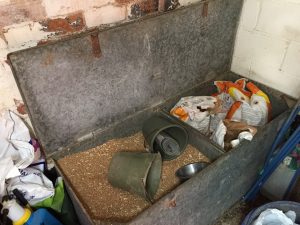
When your hens start laying you should give them layer pellets. These provide extra calcium needed for strong eggshells. If the pellets are too large, just break them up and make them easier to eat.
If you are raising quail for meat, do not give them the game bird grower mix, give them a finisher feed instead at five or six weeks old. Don’t forget to add all the grains and other goodies too.
Adult quail eat anywhere between .5 and .88 ounces (15 – 25 grams) of feed per day. Your daily cost depends on the price of feed in your area. If there are several outlets in your region, you should price check to find the most economical option.
What you shouldn’t feed your quail
There are a few foods that can be toxic to quail. In most cases, they instinctively avoid these foods unless they are desperate for food. But it is best to avoid letting your birds have access to the following:
- Avocadoes
- Caffeine
- Chocolate
- Grape seeds
- Parsley
- Rhubarb
- Tomato plants (not the fruit)
- Foods that contain salt
- Uncooked potato
- Citrus fruit
- Meat products
Keeping your Quail healthy
If you keep your quail’s home clean, their water containers full of fresh, clean water, you give them plenty of living space, healthy food, and some fresh air and sunshine, you will go a long way in keeping them healthy, stress-free, and strong.
But, no matter how careful you are, sometimes birds can get sick. There are some common quail illnesses that you should be on the lookout for.
- Ulcerative Enteritis, also known as ‘deadly quail disease’ (!!). This disease is caused by bacteria that come from eating bird droppings, or through transmission by infected flies. Ulcerative Enteritis causes ulcer in the quail’s digestive tract. Some of the symptoms include:
- Lethargy and drooping wings
- A puffy and pale appearance
- Watery droppings
This disease is quite contagious. If you suspect a bird has it, separate it from the others, clean out the coop, and call your vet for treatment advice.
- Coryza is also a bacterial infection. It is like a cold or flu and affects the bird’s respiratory system. Some of the most common symptoms include:
- A snotty, runny beak and watery eyes
- Lethargy
- A puffy face
- Wheezing sounds when breathing
- Bad odor coming from the bird
Your vet will prescribe antibiotics for Coryza. You should separate any sick birds from the flock and get the coop, water, and feed troughs cleaned up thoroughly.
- Coccidiosis is a common illness that affects young birds. It is caused by a protozoa that is eaten and enters the digestive system. It is usually transferred through feces. That is why it is so important to have a clean coop. You don’t want your birds eating food mixed with poop. Some of the symptoms of Coccidiosis are:
- Loss of appetite and weight loss
- Ruffled feathers and drooping wings
- Closed eyes, the birds look sleepy
Corid is the name of a standard treatment for this illness. You can probably find it at the same store where you buy your quail feed. It comes in powdered form that you add to the water supply.
You are now ready to raise Quail!
Raising quail is an extremely rewarding experience. These small birds have a sweet temperament, are very affectionate, they don’t mind being handled, and they will eat right out of your hand. Taking care of quail is something the entire family can do. You won’t have to worry about your young children getting hurt, they won’t pick at them like chickens, or chase after them like ducks do sometimes. Not only are quail relatively inexpensive to raise, they will provide you with lots of yummy eggs and meat. They don’t need as much space as other birds, and they are quieter and cleaner too – so go for it!


